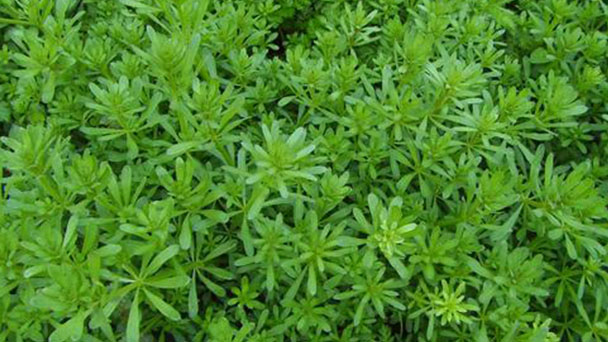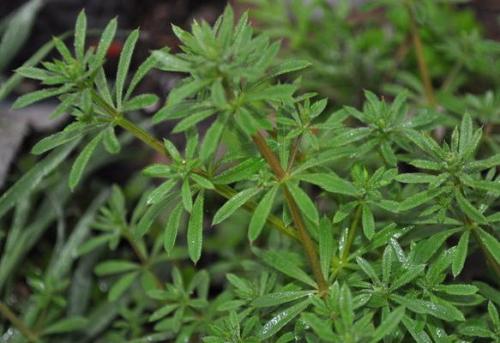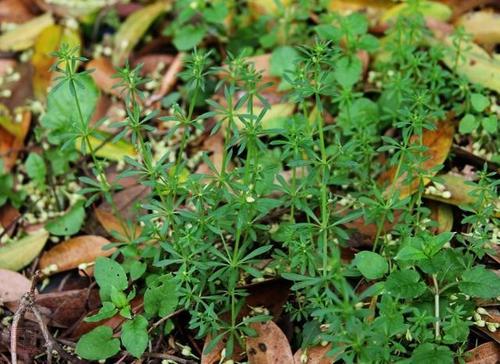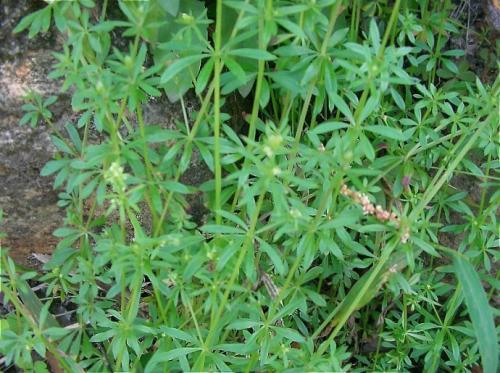Cleavers (Galium aparine) profile
Written by admin
Mar 05 2021

Cleavers, scientific name Galium aparine, also called hitchhickers, clivers, bedstraw, goosegrass, catchweed, stickyweed, sticky bob, stickybud, stickyback, robin-run-the-hedge, sticky willy, is a plant of the genus Lallaria in the Rubiaceae family. Cleavers are multi - branched, trailing or climbing herbaceous, in the elevation of 20-4600 meters of the hillside, wilderness, ditch, beach, field, forest margin, grassland. About 300 species worldwide occur in wet woodlands, marshes, river banks and coastal areas. Cleavers are a malignant weed in the field of summer ripe dry crops, and also have the function of antihypertensive and anti-cancer.
Cleavers picture

Morphological characteristics of Cleavers
Cleavers are multi-branched, trailing or climbing herbs, usually 30-90 cm tall; Stem is 4-angled; There are inverted spines on edges, leaf margins and veins. Leaves are papery or submembranous, 6-8 whorled, rare to 4-5, banded oblanceolate or oblong-oblanceolate, 1-5.5 cm long and 1-7 mm wide, apical with needle-like convex heads, base tapering, often closely spiny hairs on both surfaces, often flaccid, stem often curled, 1-veined, subsessile. Cymes of Cleavers are axillary or terminal, few to many flowered, flowers small, 4-numbered, with slender pedicels; Calyx is hooked, calyx eaves subtruncate; Corolla is yellow-green or white, radiate, lobes oblong, less than 1 mm long, valvate; Ovary of Cleavers is hairy, style 2-lobed to middle, stigma capitate. Fruit is dry, with 1 or 2 subglobose mericarps, up to 5.5 mm in diam., swollen, densely hirsute, pedicel straight, up to 2.5 cm long, thick, each mericarp with 1 plane-convex seed.
Cleavers have lobed, often needle-like leaves with 4 to 8 whorls. Flowers are small, tufted, green, yellow, or white. Fruit is hard, round, two united. Northern Cleavers(G. Boreale), Bog Cleavers(G. Palustre) and Goose Cleavers(G. Aparine) were found throughout Europe and naturalized in some parts of North America. Cleavers(G. Odoratum or Asperula Odorata) have the smell of freshly cut hay. When the young ground is dried, Cleavers can be used for spices, sachets and drink flavorings. Yellow Cleavers(G. verum) were used in Europe to curdle milk and color cheese. The root tubers of several species of the genus can be used to make red dyes.
Cleavers is a small herb of Rubiaceae, belonging to dicotyledons. The tender shoots can be used as vegetables, it is said that pigs eat the disease, so it was named Cleavers.
Ecological habits of the Cleavers
Cleavers were born on hillsides, open fields, gullies, river banks, fields, forest margins and grasslands 20-4600 meters above sea level.
The distribution area of Cleavers
Cleavers are distributed all over China except Hainan and the South China Sea islands. Japan, Korea, Russia, India, Nepal, Pakistan, Europe, Africa, North America and other regions are distributed.

Plant hazards of Cleavers
Hazard area
Cleavers distribute as far north as Liaoning, south to Guangdong, Guangxi. It is a malignant weed in the field of summer ripe dry crops.
Damage to crops
In North China, Northwest China and the Huaihe River Basin, the damage to wheat and rapeseed occurred in a large area. In the south of the Yangtze River Basin, the damage to wheat and rapeseed was limited to mountain slopes, and the damage to wheat and rapeseed was greater than that to rapeseed. Climbing plants not only compete for sunlight and space with crops, but also cause crop lodging, resulting in greater yield reduction and affecting crop harvesting.
Chemical control
Wheat field control with the herbicide, such as paracarpus, giant star, broadgrass clear; Rape field with dry grass Ling, Wo Nai Si, GaoTeKe and other herbicides.
Cleavers uses
Medicinal s use of cleavers
Cleavers has lengthy been used as a slimming aid, possibly due to the fact of its diuretic properties. Worldwide, cleavers most frequent use has been as a cleaning herb for treating illnesses from kidney and urinary problems to infections and itching. It is tremendous for pores and skin prerequisites like eczema.
Other uses
In different uses, now surpassed into antiquity, the sticky seeds have been used by using lacemakers to extend pinheads, and the root itself yielded a pink dye.

Latest Updated
- Benefits of Bugleweed - 7 Science-backed Health Benefits
- Bugleweed Dangers & Side Effects - Is It Poisonous?
- How to Plant Evergreen Trees - What You Should Know
- When to Plant Evergreens - Grow Guide for Evergreen Trees
- 12 Wonderful Evergreen Shrubs for Your Garden
- 12 Popular Evergreen Plants with Pictures for Beginners
- When And How To Prune A Lilac Bush Like a Pro
- How to Grow & Care for Lilac Vine (Hardenbergia Violacea)
- Japanese Lilac Tree (Syringa Reticulata) Care & Propagation Guide
- Shumard Oak Pros and Cons - What to Know
Popular Articles
- Winter maintenance of Antirrhinum Majus
- How to Grow Terminalia Mantaly Tree
- How to Grow and Care for Crossostephium Chinense
- How to grow Antirrhinum Majus in spring
- Peristeria Elata (Dove Orchid) Profile: Info & Care Guide
- Underwatered Snake Plant (Sansevieria Trifasciata) - Signs And How To Fix
- How to Care for Brazilian Jasmine Plant (Mandevilla Sanderi)
- How to Grow & Care for Graptopetalum Purple Delight in Summer
- Rosa Chinensis (China Rose): Plant Growing & Care Tips
- How to Care for Baby Sun Rose (Aptenia Cordifolia)